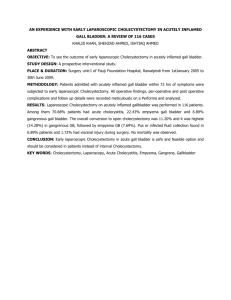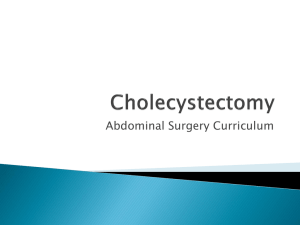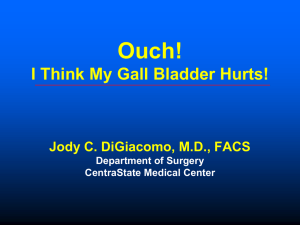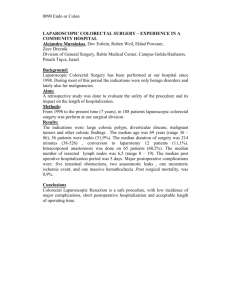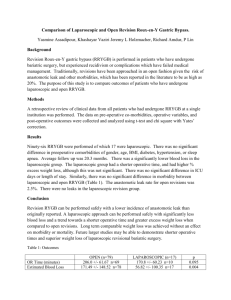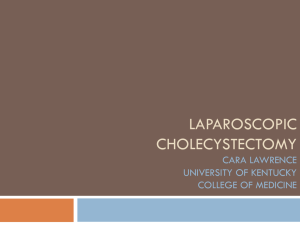Dr. Ajay Gangji
advertisement
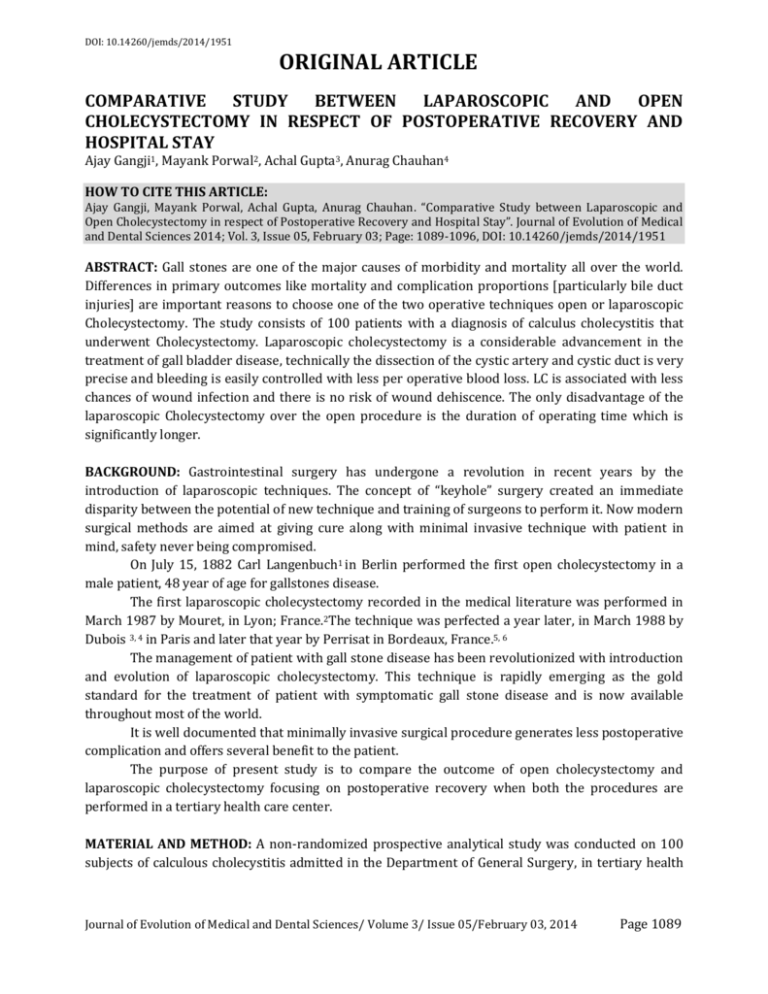
DOI: 10.14260/jemds/2014/1951 ORIGINAL ARTICLE COMPARATIVE STUDY BETWEEN LAPAROSCOPIC AND OPEN CHOLECYSTECTOMY IN RESPECT OF POSTOPERATIVE RECOVERY AND HOSPITAL STAY Ajay Gangji1, Mayank Porwal2, Achal Gupta3, Anurag Chauhan4 HOW TO CITE THIS ARTICLE: Ajay Gangji, Mayank Porwal, Achal Gupta, Anurag Chauhan. “Comparative Study between Laparoscopic and Open Cholecystectomy in respect of Postoperative Recovery and Hospital Stay”. Journal of Evolution of Medical and Dental Sciences 2014; Vol. 3, Issue 05, February 03; Page: 1089-1096, DOI: 10.14260/jemds/2014/1951 ABSTRACT: Gall stones are one of the major causes of morbidity and mortality all over the world. Differences in primary outcomes like mortality and complication proportions [particularly bile duct injuries] are important reasons to choose one of the two operative techniques open or laparoscopic Cholecystectomy. The study consists of 100 patients with a diagnosis of calculus cholecystitis that underwent Cholecystectomy. Laparoscopic cholecystectomy is a considerable advancement in the treatment of gall bladder disease, technically the dissection of the cystic artery and cystic duct is very precise and bleeding is easily controlled with less per operative blood loss. LC is associated with less chances of wound infection and there is no risk of wound dehiscence. The only disadvantage of the laparoscopic Cholecystectomy over the open procedure is the duration of operating time which is significantly longer. BACKGROUND: Gastrointestinal surgery has undergone a revolution in recent years by the introduction of laparoscopic techniques. The concept of “keyhole” surgery created an immediate disparity between the potential of new technique and training of surgeons to perform it. Now modern surgical methods are aimed at giving cure along with minimal invasive technique with patient in mind, safety never being compromised. On July 15, 1882 Carl Langenbuch1 in Berlin performed the first open cholecystectomy in a male patient, 48 year of age for gallstones disease. The first laparoscopic cholecystectomy recorded in the medical literature was performed in March 1987 by Mouret, in Lyon; France.2The technique was perfected a year later, in March 1988 by Dubois 3, 4 in Paris and later that year by Perrisat in Bordeaux, France.5, 6 The management of patient with gall stone disease has been revolutionized with introduction and evolution of laparoscopic cholecystectomy. This technique is rapidly emerging as the gold standard for the treatment of patient with symptomatic gall stone disease and is now available throughout most of the world. It is well documented that minimally invasive surgical procedure generates less postoperative complication and offers several benefit to the patient. The purpose of present study is to compare the outcome of open cholecystectomy and laparoscopic cholecystectomy focusing on postoperative recovery when both the procedures are performed in a tertiary health care center. MATERIAL AND METHOD: A non-randomized prospective analytical study was conducted on 100 subjects of calculous cholecystitis admitted in the Department of General Surgery, in tertiary health Journal of Evolution of Medical and Dental Sciences/ Volume 3/ Issue 05/February 03, 2014 Page 1089 DOI: 10.14260/jemds/2014/1951 ORIGINAL ARTICLE care center who underwent cholecystectomy from Nov. 2012 to Oct. 2013. In this duration initial 50 subjects each were assigned to laparoscopic cholecystectomy group and open cholecystectomy group. The patients were interviewed for detailed clinical history according to a definite proforma. All the patients were examined and underwent routine blood investigations and abdominal USG was performed in all the cases. The patients with cholelithiasis proven by USG with at least one attack of upper abdominal pain and considered fit for elective cholecystectomy were included in the study. The patients above age 70 years, with history or investigation suggesting CBD stones, history of prior abdominal surgery and patients who have any contraindication to laparoscopic surgery were excluded from study. Patients were selected into two groups of [laparoscopic cholecystectomy and open cholecystectomy] 50 each. One group of initial 50 cases was subjected to laparoscopic cholecystectomy and second group of initial 50 cases was subjected to open cholecystectomy. Pain in the post-operative period was rated by each patient using a Visual Analogue Scale [from 0 to 5]. Patients were encouraged to resume work and normal daily activity as soon as possible. Evaluation of return to normal daily activity and post-operative complications was made during an outpatient door appointment two weeks after surgery. Data was collected prospectively and included patient’s demographics, operative findings, requirement for conversion to open cholecystectomy, operating time [from incision to closure], perioperative bleeding, operative complications, and duration of post-operative pain, analgesic administration and length of hospital stay along with postoperative complications if any. RESULTS: Maximum number 37% of the patients operated were belonging to 30-35 years in both groups. Male to Female ratio was 2:48for LC group and 4:46 for OC group [as gall stone disease more common in female patients].Majority of the patients in both the groups had multiple stones [84% in LC group and 78% in OC group].Operative time was higher in LC group [88.55 min.] as compared to OC [71.20 min.]. Five patients [10%] of laparoscopic group required conversion to open procedure. The Visual Analogue Scale for pain in the postoperative period was significantly less for LC patients compared to OC patients [VAS Grade, pain duration and analgesic duration were 2, 3 days and3 days for LC group and 3, 5 days and7 days for OC group]. Postoperative complications were higher in OC group as compared to LC group [30% in OC group and 14% in LC group].Postoperative hospital stay was shorter in LC group [3.4 days] as compared to OC group [7 days].Time taken to return to normal daily activity was significantly less in LC group [4.2 days] as compared to OC group [7 days]. DISCUSSION: In our study operative times was 88.55 min. (40-170) for LC group and 71.20 min. (40100) for OC group. While operative time in other study, Porte RJ et al 775 min. [40-180] for LC group and OC group 55min. [20-155], Lujan et al 888 min.[30-180] for LC group and 77 min.(30-165), Axel Ros et al 9 108min.[78-133] for LC group and 94 min.[64-118] for OC group. In our study operative time was more in LC group and highly significant by T- test [P<0.0001], because of learning curve in LC in our institute. This “learning curve” represents adapting to operating in the 2-D screen, becoming accustomed to the technique. In our study there were no major complication and several minor ones. There was no perioperative mortality and no CBD injury. The complications observed Journal of Evolution of Medical and Dental Sciences/ Volume 3/ Issue 05/February 03, 2014 Page 1090 DOI: 10.14260/jemds/2014/1951 ORIGINAL ARTICLE were bile spillage, stone spillage and blood loss which were found to be comparable in both the groups. In our study VAS Grade, pain duration and analgesic duration were 2, 3 days and 3 days for LC group and 3, 5 days and 7 days for OC group. There was significant difference in duration of pain [p<0.000] and analgesic duration [p<0.000] between LC group and OC group. Chan HS et al 10 1995, postoperative outcome was assessed subjectively by a single observer using VAS and objectively by assessment of parenteral analgesic used and had a shorter mean post-operative hospital stay [3.5 days v/s 5.9 days, p<0.01]. Buanes T et al 11 1995, de Pouvouiville G et al 121997, Hendolin HI et al 13 2000, Schietroma M et al 14 also found pain and discomfort were significantly lower in LC group than OC group. The Hospital stay in both the surgeries has been compared to other studies. In our study mean post-operative hospital stay 3.2 days [2-7 days], 7 days [4-15 days] and 6.8 days [5-10 days] for LC group, OC group and converted to OC group. Postoperative hospital stay was significantly less in LC group [P<0.000]. While in other study like Buanes T et al 11 1996, Porte RJ et al 7 1996, Lujan et al 8 1998, al Haidi et al 15 1998, Hendolin HI 13 2000 post-operative hospital stay 2-3 days for LC group and 4-8 days for OC group. In our study time taken to return to normal daily activity was 4.04 days [3-9 days], 8 days [515 days] and 8.4 days [7-12 days] for LC group, OC group and converted to OC group. In other study of Buanes T et al 11 1995, 10 days for LC group and 28 days for OC group, Schietrroma et al 14 2001study 4.4 days for LC group and 7.6 days for OC group. Our study was comparable to other studies that was significantly less in LC compared to OC [P<0.000]. The two most beneficial aspects of LC were the shorter hospital stay and the rapid recovery in our study. CONCLUSION: We can be conclude that Laparoscopic cholecystectomy is a considerable advancement in the treatment of gall bladder disease. The advantages of laparoscopic cholecystectomy are several: LC is associated with less chance of wound infection and there is no risk of wound dehiscence. The degree of post-operative pain and its duration is less. The duration of analgesic requirement is less in LC. LC patients tolerate oral feeds earlier and are mobilized faster. The duration of hospital stay is less and patients can be discharged quickly from the hospital. Patients of LC group can resume their work earlier. LC is associated with significant financial saving to the patient. The only disadvantage of the laparoscopic cholecystectomy over the open procedure is the duration of operating time which is significantly longer. BIBLIOGRAPHY: 1. Traverso LW. Carl Langenbuch and the first cholecystectomy. Am J Surg. 1976; 132(1): 81-82. 2. Mouret P. From the first laparoscopic cholecystectomy to the frontiers of laparoscopic surgery the future prospective. Dig Surg. 1991; 8: 124-125. 3. Dubois F, Bethelot G, Levard H. Laparoscopic cholecystectomy historical perspective and personal experience. Surg Laprosc Endosc. 1991; 4: 52-57. 4. Dubsis F, Icard P, Pethelot G et al. Laparoscopic cholecystectomy: Preliminary report of 36 cases. Ann Surg. 1990; 211: 60-62. Journal of Evolution of Medical and Dental Sciences/ Volume 3/ Issue 05/February 03, 2014 Page 1091 DOI: 10.14260/jemds/2014/1951 ORIGINAL ARTICLE 5. Perrisat J, Collet D. Gallstones: laparoscopic treatment; cholecystectomy; cholecystoscopy and lithotripsy. Surg Endosc. 1990; 4: 1-5. 6. Reddick E, Olsen D, Daniell J et al. Laparoscopic laser cholecystectomy. Laser Med Surg. 1989; 3: 38-40. 7. Porte RJ, De Vries BC. Laparoscopic versus open cholecystectomy: a prospective matchedcohort study. HPB Surg. 1996; 9(2): 71-75. 8. Lujan JA, Parrilla P, Robles R et al. Laparoscopic versus open cholecystectomy in the treatment of acute cholecystitis: a prospective study. Arch Surg. 1998; 133(2): 173-175. 9. Ros A, Gzstafsson L, KrookH et al. laparoscopic cholecystectomy versus mini laparoscopic cholecystectomy; A Prospective, Randomized, single-Blind study. Ann Surg. 2001; 234(6): 741749. 10. Chan HS, Ha XF, Mack P et al. A prospective comparative study between conventional and laparoscopic cholecystectomy. Singapore Med J. 1995; 36(4): 406-409. 11. Buanes T, Mjaland O. Complications in laparoscopic and open cholecystectomy: a prospective comparative trial. Surg Laparosc Endosc. 1996; 6(4): 266-272. 12. dePouvourvile G, Ribet-Reinhart N, Fendrick M. A prospective comparison of costs and morbidity of laparoscopic versus open cholecystectomy. Hepatogastroenterology. 1997; 44(13): 35-39. 13. Hendolin HI, Paakonen ME, Alhava EM et al. Laparoscopic or open cholecystectomy: a prospective randomized trial to compare postoperative pain, pulmonary function and stress response. Eur J Surg. 2000; 166(5): 394-399. 14. Schietroma M, Carlei F, Liakos C et al. Laparoscopic versus open cholecystectomy: An analysis of clinical and financial aspects. Panminerva Med. 2001; 43(4): 239-242. 15. al Hadi FH, Chiedozi LC, Salem MM et al. Comparison of laparoscopic and open cholecystectomy at Prince Abdulrahman Al Sudairy Hospital: Saudi Arabia. East Afr Med J 1998; 75(9): 536-539. Journal of Evolution of Medical and Dental Sciences/ Volume 3/ Issue 05/February 03, 2014 Page 1092 DOI: 10.14260/jemds/2014/1951 ORIGINAL ARTICLE Journal of Evolution of Medical and Dental Sciences/ Volume 3/ Issue 05/February 03, 2014 Page 1093 DOI: 10.14260/jemds/2014/1951 ORIGINAL ARTICLE Journal of Evolution of Medical and Dental Sciences/ Volume 3/ Issue 05/February 03, 2014 Page 1094 DOI: 10.14260/jemds/2014/1951 ORIGINAL ARTICLE Journal of Evolution of Medical and Dental Sciences/ Volume 3/ Issue 05/February 03, 2014 Page 1095 DOI: 10.14260/jemds/2014/1951 ORIGINAL ARTICLE AUTHORS: 1. Ajay Gangji 2. Mayank Porwal 3. Achal Gupta 4. Anurag Chauhan PARTICULARS OF CONTRIBUTORS: 1. Associate Professor, Department of General Surgery, G.R. Medical College, Gwalior. 2. RSO, Department of General Surgery, G.R. Medical College, Gwalior. 3. Professor and HOD, Department of General Surgery, G.R. Medical College, Gwalior. 4. Assistant Professor, Department of General Surgery, G.R. Medical College, Gwalior. NAME ADDRESS EMAIL ID OF THE CORRESPONDING AUTHOR: Dr. Ajay Gangji, Associate Professor, Department of General Surgery, G.R. Medical College, Gwalior, (M.P) E-mail: drajaygangji@gmail.com Date of Submission: 10/01/2014. Date of Peer Review: 11/01/2014. Date of Acceptance: 14/01/2014. Date of Publishing: 28/01/2014. Journal of Evolution of Medical and Dental Sciences/ Volume 3/ Issue 05/February 03, 2014 Page 1096
